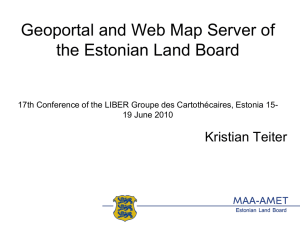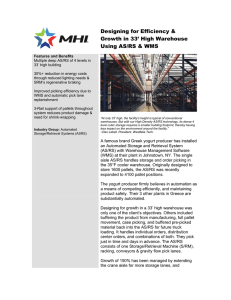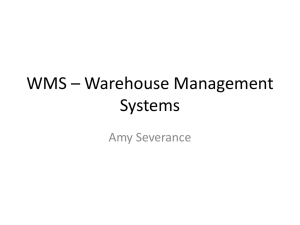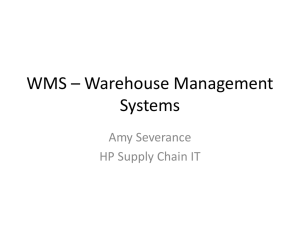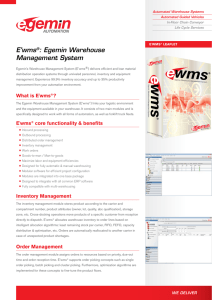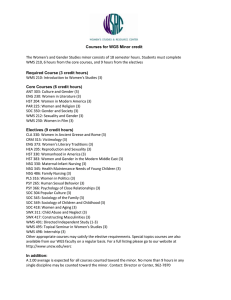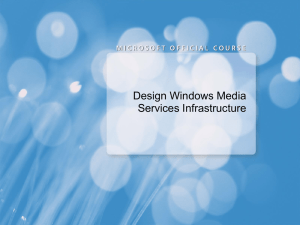Warehouse Management Solutions: An Epicor White Paper
advertisement
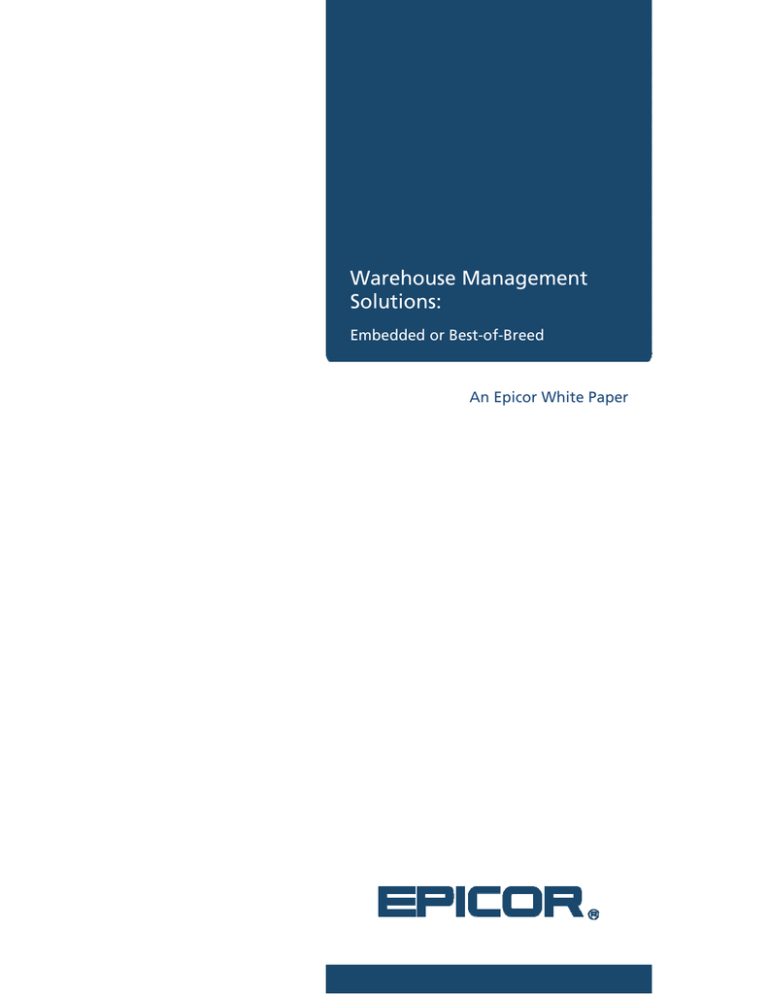
Warehouse Management Solutions: Embedded or Best-of-Breed An Epicor White Paper WHITE PAPER Executive Summary As manufacturers and distributors come under rising pressure for faster fulfillment of product orders and outstanding customer service, they increasingly ask the question, “Would a warehouse management system1 (WMS) help us better manage and automate our warehouse and fulfillment operations?” Often, they are finding that a WMS would, indeed, provide the benefits they seek. Your company may be coming to the same conclusion. As you begin to examine the various WMS offerings, you encounter the dilemma of whether a stand-alone WMS simply integrated with an ERP solution or a WMS module that is part of a broader ERP suite would be your best choice. Not long ago, the embedded versus stand-alone WMS decision was made easier because standalone systems generally provided broader WMS functionality than what was found in ERP systems. Fortunately, this is no longer the case. Some leading ERP vendors have closed the gap with standalone systems. In addition to closing the functionality gap, these embedded WMS solutions provide benefits beyond what stand-alone or best-of-breed (BOB) solutions can in terms of integration, the ability to have one vendor relationship versus multiple, an overall lower cost of ownership, and more. Regardless of what strategy you choose to pursue—stand-alone or embedded—your chosen solution must accomplish the goals established for it with a minimum of disruption for implementation and integration. Achievable WMS goals often include greater customer satisfaction through shorter cycle times and 100% accurate deliveries, as well as better utilization of warehouse resources, inventory reduction and increased productivity. Selecting the right WMS solution is so important that all pertinent considerations should be examined. This paper can help you identify and examine the vital points to consider as you seek the best WMS solution to accomplish your goals and move your company into a more competitive position. 1 According to Gartner’s online glossary, “WMS are applications that manage the operation of a warehouse or distribution center. Functionality includes receiving, put -away, inventory management, cycle counting, task interleaving, wave planning, order allocation, order picking, replenishment, packing, shipping, labor management and automated material-handling equipment interfaces. Using radio frequency (RF) technology in conjunction with bar codes provides the foundation of WMS, delivering accurate information in real time.” Warehouse Management Solutions: Embedded vs. Best-of-Breed i WHITE PAPER Table of Contents The Functionality Debate: Stand-Alone versus Best-of-Breed 1 Level of Integration 2 Cost Factors to Consider 3 Purchase and Licensing Costs 3 Maintenance and Support 4 Implementation 4 Integration 4 Training 5 Upgrading 5 The Consolidation Factor 6 Making the Best Decision for Your Company 7 Epicor’s Supply Chain Management Solution 8 About Epicor 9 Warehouse Management Solutions: Embedded vs. Best-of-Breed ii WHITE PAPER The Functionality Debate: Stand-Alone versus Best-of-Breed The functionality question causes confusion in the minds of WMS seekers because WMS-based vendors (often called best-of-breed [BOB]) continue to purport that their systems are functionally superior to WMS applications embedded within ERP solutions. The market is realizing that this no longer holds true. In a recent research paper from META Group, the analyst group reported that “In a recent research article from Gartner, Inc., the analyst group reported that, “Right or wrong, the tendency has been for companies to overreach when defining next generation application requirements in WMSs. Although more functionality might seem better than less, aiming beyond a company's needs can wrongfully preordain a WMS shortlist (for example, best-of-breed versus an ERP WMS) and can add unnecessary cost and complexity. As the WMS market evolves from a best-of-breed-dominated market to one where many ERP vendors now offer reasonable WMS solutions for varying levels of need, it is important that the requirements be realistic to determine the right shortlist of vendors.”2 Jane Barrett, research director with AMR Research’s Industry Value Chain Strategies Service noted, “a recent study revealed the importance of logistics, including warehouse management. Warehouse management system (WMS) software was rated the most important supply chain application investment over the next two years.”3 Given this, companies should not overlook WMS solutions sold as part of a broader enterprise suite for fear that they will be required to compromise on functionality. There are a number of reasons why including embedded WMS solutions in their evaluations would be a wise step in the search for the best WMS solution. The embedded WMS solution’s avoidance of redundant functionality issues and already complete integration are two compelling reasons for including the embedded WMS in your evaluation. Beyond closing the functionality gap with stand-alone solutions, it is important to recognize the lack of redundant functionality within an embedded system versus a BOB system paired with an ERP system. Because WMS systems are designed to manage the warehouse and all of the activities that take place in it, they provide some of the same functions of a traditional ERP system. This can be problematic when attempting to interface a standalone WMS. Many hours can be devoted to deciding which system’s functions would be most effective for which processes. Worse yet, if the same function is allowed to operate in both systems, for example, inventory adjustments, balances can quickly get out of sync. The answer to which system’s function should be used may not be known until the stand-alone system is in use. By then, additional expense and disruption may be required to disable the less efficient function and its related functions in one system and activate the counterpart functions in the other system. 2 Gartner, Inc., “Stratifying WMS: A Multilevel View” by C. Dwight Klappich (Feb. 19, 2009) 3 AMR Research, “Four Tactical Initiatives to Help Your Company Through the 2008 Automotive Downturn” by Jane Barrett (Apr. 7, 2008) Warehouse Management Solutions: Embedded vs. Best-of-Breed 1 WHITE PAPER ERP developers of embedded WMS functions have already tackled this issue. Having implemented the ERP/WMS system for other manufacturers and distributors, they know which functions handle which tasks most efficiently. Generally, these systems have little or no functional redundancy because they are designed from the outset to work together in maximum harmony. Level of Integration WMS functionality included with the ERP system is an integral part of the system. This avoids the time and expense to map the BOB WMS functions to the ERP system’s customer, supplier, location and product records, business rules and automated messaging and workflow capabilities. WMS capabilities that are embedded in the ERP system eliminate the interfacing difficulties that can arise with stand-alone systems. According to a recent article by Technology Evaluation Centers, Inc. (TEC), “Extending that existing enterprise suite with straightforward technology designed to direct workers in the warehouse can be easily achieved without a stand-alone WMS solution.”4 Furthermore, “ERP - distribution software has been developed to meet the growing needs of the manufacturing and distribution industries. The capabilities incorporated into the software work across entire organizations, and even across continents.” 5 Beyond the integration issues, there is consideration of how the integration will take place. With an embedded solution, there is no synchronization required—they operate as one solution. As the WMS system manages inventory receipts, moves, and shipments in the warehouse, the inventory records in the ERP system must be updated in real time. Conversely, when the ERP system generates pick tickets for production order parts, the WMSbased inventory records must reflect the activity. As events occur in either solution, alerts and communications must flow automatically to and from the warehouse, plant and service areas and across the supply chain to keep the organization informed and running smoothly. This level of synchronization may be difficult to achieve with a stand-alone system. Some BOB offerings rely on two separate databases or stores, where records and activities are replicated back and forth, causing processing and visibility delays. This adversely impacts response ability, for example, in customer service, because fulfillment activities executed in the WMS are not visible to the ERP system immediately, and the information available to sales or service reps is not current. Timeliness of information should be a primary criterion of the WMS module/BOB comparison. Despite these issues, data synchronization is the easy part. Synchronizing the best practices and business rules across your organization is harder. A single set of business processes and/or rules helps move your organization toward your goals. Multiple solutions allow alternate practices and varied rules and potentially drive a wedge between you and your goals. 4 TEC, “Warehouse Management for Manufacturers: Why Extended ERP Might be the Right Choice” (June 16, 2008) 5 TEC, “From Manufacturing to Distribution: the Evolution of ERP in Our New Global Economy” (Aug. 20, 2008) Warehouse Management Solutions: Embedded vs. Best-of-Breed 2 WHITE PAPER The real issues arise when things do not go as planned. If the warehouse is using a different system than the sales and/or customer service organization, it becomes more difficult to guarantee the warehouse will honor promises made by sales and customer service? For example, a specific customer order must ship complete today even though you don’t have inventory and the truck leaves in half an hour? Perhaps a promotion exceeded expectations and your customer requires an emergency shipment. How will you insert an order line onto an order already in the warehouse? Customers will expect that a promise made by their sales or customer service representative will be upheld by others in the organization. Customer service and warehouse operations need a single application that will enable them to keep the commitments made to customers. Cost Factors to Consider Often, one of the primary reasons for implementing a WMS is to reduce costs. If you elect to implement a best-of-breed solution, it is likely that you’ll be increasing costs in a number of areas. Separate applications can double many of your costs including storage costs, operational costs, and maintenance costs. The cost of automating their warehouse and distribution operations is a major concern for most WMS seekers. Understanding cost differences between stand-alone WMS software packages and an embedded WMS solution that is part of a broader suite can help the project team clearly identify which avenue provides the best solution for their requirements and their budget. When evaluating solutions, it is important to consider what the total cost of the solution will be—looking beyond the purchase price to costs such as maintenance, support, integration and upgrading. Purchase and Licensing Costs Companies looking for a WMS solution need to compare the purchase cost of the stand-alone solution versus the embedded. The analysis should go beyond the WMS portion of the software. What will be the costs of additional components that work with the system? For example, you will want to have business intelligence solutions available that reach across your ERP and WMS solutions. Will you be required to purchase a separate solution for business intelligence if you go the stand-alone route? Many enterprise software providers have developed business intelligence suites that already incorporate data analysis capabilities across the traditional ERP solution and WMS solution. Warehouse Management Solutions: Embedded vs. Best-of-Breed 3 WHITE PAPER Maintenance and Support An additional cost consideration often directly tied to the purchase price is the cost for maintenance and support. The up -front costs for licensing the software typically have a significant impact on the maintenance fees and costs that your organization will incur. Generally, maintenance costs are based on the license cost of the software. The rates can vary by vendor and type of application. As you evaluate and compare the costs to license your new WMS solution, make sure you incorporate the costs to stay on maintenance as well. Beyond considering the maintenance costs, it is important to consider how support will work on a stand-alone solution versus an embedded solution. There is a significant amount of integration required between a WMS and ERP solution. When issues arise, how will a stand-alone WMS provider work with your ERP provider to help you resolve the issue? Implementation An implementation phase is required in both stand-alone and embedded systems, although the time and costs to implement can be measurably different. Even where the ERP system is already in place, there is more to implementing an embedded WMS module than simply enabling it with a code. A successful WMS implementation occurs when functional requirements and strategic goals are met. Who is best qualified to understand the business, help simplify processes and apply the parameters that will best meet the defined objectives? The stand-alone WMS provider may know his WMS software well and even know general integration points to a number of ERP and other systems, but without inside knowledge of the customer’s environment, processes and challenges, the implementation could be cumbersome at best. In addition, implementations of stand-alone providers can take longer and cost more because integration points must be determined, mapped and tested. One or two mistakes in the process can inflict costly business interruptions. Implementation time and costs can be significantly less with embedded WMS modules because the integration points with the ERP system are already established and the two systems are designed from the start to work together. Integration Integration has been mentioned several times as a cost factor. With respect to integration, there is a cost if you elect to integrate the solutions and if you choose to run your WMS stand-alone. If no integration exists, you are potentially transferring costs from one area of your organization to another. For example, with two solutions you have to balance the inventory between both applications. You will have to call the warehouse every time you make a change to an order that the warehouse “owns.” These little costs add up and can quickly replace expected savings. You have, in effect, transferred inefficiencies from the warehouse to customer service. Warehouse Management Solutions: Embedded vs. Best-of-Breed 4 WHITE PAPER If you do elect to integrate the solution, there are costs associated with that decision—costs to develop the integration, maintain it, and move it forward to the next version when you upgrade. The physical integration process (moving data between the two applications) requires server processing. The desirable real-time integration requires extracting, transforming and loading each transaction. You will need additional hardware and additional maintenance on that hardware. Training Initial education on the system may or may not be priced separately from implementation; however, there is certainly a cost to the time it takes for users to become productive. The sooner users are educated on the benefits of the system and trained to use the system, the faster the company begins realizing return on their investment. When the WMS is an extension of the ERP system with which users are already familiar, the learning curve for the WMS is compressed. If the two products have a similar look and feel it will enable workers to achieve faster productivity than when attempting to learn two disparate systems. Instructors who are familiar with the manufacturer or distributor’s business can dispense training that is specifically relevant to the environment and goals of the company. This is focused education that delivers an understanding of how functions of the new system impact the enterprise and supply chain as a whole. The more familiar the instructor is with the environment, the more valuable this training will be. The ERP provider may have a distinct advantage over the stand-alone/BOB WMS provider in this area of environment familiarity. In addition, because the BOB provider may be unsure how the ERP system executes certain functions that impact the WMS, the BOB education process may be longer and less effective. Upgrading Enhancement-bearing service packs or upgrades to an embedded WMS are delivered as part of the systematic upgrades to the ERP software. Because they are tested by the ERP provider prior to being released, new or enhanced WMS functionality is really like any new ERP feature and is ready to use. Expect enhancements to stand-alone WMS software to cause some business disruption while the new features are mapped to the ERP system and then tested prior to usability. Training on the new features would also cost additional time and expense over the all encompassing training on WMS/ERP new capabilities. Also, when two or more different software providers are developing the enterprise’s primary software systems, rarely would service pack enhancements, upgrades or new releases coincide. This can result in technologies being out of sync and incompatible until the lagging system is upgraded. Additional consulting time is often required in the interim to bring the technologies in compliance with one another. Warehouse Management Solutions: Embedded vs. Best-of-Breed 5 WHITE PAPER The Consolidation Factor Beyond actual costs, there are additional factors for organizations to consider. One of those factors is industry consolidation. Software company consolidations abound in recent years. The WMS seeker’s fear is that the system they choose will cease to be a development focus for the company that acquires their WMS-based vendor. If that happens, the system could quickly become obsolete. Concern about consolidation in the supply chain vendor arena is well founded. According to Steve Banker, an analyst at ARC Advisory Services, “Like companies in other mature industries, I expect the [WMS] industry will continue to consolidate, to the point where we have just a handful of suppliers in each area, and the leader has something like a 35% market share.” 6 While it is unlikely that any provider will give an iron-clad guarantee to put these concerns to rest, the risks can be mitigated. A WMS embedded into the ERP system of a financially viable provider can be your best hedge against disappearance of your WMS developer and system obsolescence. 6 Supply Chain Digest, “News and Views: Supply Chain/Warehouse Management Industry Continues Consolidation.” (Jan. 23, 2006) Warehouse Management Solutions: Embedded vs. Best-of-Breed 6 WHITE PAPER Making the Best Decision for Your Company Selecting a WMS is not a trivial decision for any company. A project team or selection group wants to ensure that their recommendation will prove to be the best for their company and deliver the results envisioned. And they want to choose a provider who will be able to provide expertise and support long after implementation. Successful implementation of a WMS requires the buy-in of the users, executives, warehouse managers and others. Strategic goals, such as improved customer service or marketplace differentiation, must be determined based on cross-departmental input, not just at the IT or even the executive level. When a careful assessment of the company’s needs reveal that a WMS system may provide the correct solution, seek answers to questions such as: “When evaluating the requirements of a WMS for your demand-driven transformation, consider the advantages made possible by the advances in senseand-respond technologies, the evolution of WMS to integrated supply chain execution suites, and the availability of the new SOA architecture ” Which product and provider can most easily accommodate change and support future directions? Is the provider I’m considering financially viable? Which will cause the least disruption—initially and ongoing? What is the initial cost and the total cost of ownership and is it justifiable? Which package provides an end-to-end solution? Who is the best long-term partner? How will this vendor support me in cases where issues and requests involve more than the WMS solution (e.g. the WMS and ERP solution)? How will the customer service organization and the warehouse team communicate order changes? How quickly will changes in order and inventory status be available to customers on a self-service portal? Beyond these questions, one of the best indicators of how the solution might work for you will be the ability for you to speak with references. You’ll want to talk with references that can speak to the functional capabilities of the WMS as well as to how the solution integrates with other systems that the company uses and what the costs have been to build and maintain that integration. Evaluating solutions based on the questions above and the responses of reference accounts should enable you to make an informed decision about choosing a stand-alone solution or an embedded WMS. Warehouse Management Solutions: Embedded vs. Best-of-Breed 7 WHITE PAPER Epicor’s Supply Chain Management Solution Epicor’s supply chain management (SCM) solution goes beyond traditional ERP to incorporate fully integrated WMS capabilities, with functionality typically only found within purpose built stand-alone WMS—until now. Designed for the specific needs of fulfillment service providers in addition to conventional warehouse management, Epicor WMS solutions provide complete control, management and visibility of all logistics and SCM management operations. Epicor WMS software features extensive warehouse management capabilities, including: Total warehouse management, inventory control, finite bin and package definitions, task and load management and inter-active, real-time management of activities and consumption. Multi-Channel order processing with automated EDI, kitting and item configuration. Inbound and outbound serial tracking, pick planning, consolidated picking, order pack-out, cross-docking, carton packing, and manifesting interfaces. Epicor WMS offers a uniquely comprehensive warehousing, supply chain management and supply chain execution solution. With no black box in between, no middleware to deal with and no interfaces to maintain, Epicor WMS provides a powerful solution to address all aspects of your order fulfillment, warehousing and distribution requirements. Sell: Effectively marketing and selling your goods and services is a key ingredient for success. Epicor includes our CRM suite which enables you to successfully manage your customer relationships—from generating the initial inquiry to closing the sale and supporting a long-time customer. Plan: Executing to a solid plan is critical. Whether you are developing a budget for the year, forecasting inventory for the next quarter, or determining what orders to ship for a specific day, Epicor’s solution provides the capabilities you need to make the right decisions. Track: Keeping tight control of inventory is essential. Epicor provides robust data collection and warehouse management capabilities which enable a distributor to closely track inventory transactions. Deliver: A missed delivery could mean the loss of your biggest customer. Epicor enables your organization to increase order throughput while increasing accuracy. The solution’s fulfillment capabilities have enabled organizations to ship thousands of orders per day while maintaining exacting levels of accuracy. Analyze: Epicor includes a business intelligence solution created with the distributor in mind. In addition to helping an organization analyze categories such as sales and vendor performance, the solution provides the capability to quickly view performance within the warehouse. Warehouse Management Solutions: Embedded vs. Best-of-Breed 8 WHITE PAPER About Epicor Epicor Software (NASDAQ: EPIC) is a global leader delivering business software solutions to the manufacturing, distribution, retail, hospitality and services industries. With 20,000 customers in over 150 countries, Epicor provides integrated enterprise resource planning (ERP), customer relationship management (CRM), supply chain management (SCM) and enterprise retail software solutions that enable companies to drive increased efficiency and improve profitability. Founded in 1984, Epicor celebrates 25 years of technology innovation delivering business solutions that provide the scalability and flexibility businesses need to build competitive advantage. Epicor provides a comprehensive range of services with a single point of accountability that promotes rapid return on investment and low total cost of ownership, whether operating business on a local, regional or global scale. The Company’s worldwide headquarters are located in Irvine, California with offices and affiliates around the world. For more information, visit www.epicor.com. Disclaimer This document and its contents, including the viewpoints, dates and functional content expressed herein are believed to be accurate as of its date of publication, October 2009. However, Epicor Software Corporation makes no guarantee, representations or warranties with regard to the enclosed information and specifically disclaims the implied warranties of fitness for a particular purpose and merchantability. All information contained herein is subject to change without notice. The usage of any Epicor Software shall be pursuant to an Epicor end user license agreement and the performance of any consulting services by Epicor personnel shall be pursuant to Epicor’s standard services terms and conditions. Epicor is a registered trademark of Epicor Software Corporation. All other trademarks acknowledged. This document and its contents are the property of Epicor Software Corporation. Recipients of this document should not distribute to any third parties without Epicor’s prior written consent. Copyright © 2009 Epicor Software Corporation. For more information, contact Epicor Software Corporation: info@epicor.com or www.epicor.com. Worldwide Headquarters 18200 Von Karman Avenue, Suite 1000 Irvine, California 92612 USA Toll Free: +1.800.999.1809 Phone: +1.949.585.4000 www.epicor.com Latin America and Caribbean Blvd. Antonio L. Rodriguez #1882 Int. 104 Monterrey, Nuevo Leon, CP 64650 Mexico Phone: +52.81.1551.7100 Fax: +52.81.1551.7117 Europe, Middle East and Africa No. 1 The Arena Downshire Way Bracknell, Berkshire RG12 1PU United Kingdom Phone: +44.0.1344.468.468 Fax: +44.0.1344.468.010 Warehouse Management Solutions: Embedded vs. Best-of-Breed Asia 238A Thomson Road #23-06 Novena Square Tower A Singapore 307684 Singapore Phone: +65.6333.8121 Fax: +65.6333.8131 Australia and New Zealand Level 34 101 Miller Street North Sydney NSW 2060 Australia Phone: +61.2.9927.6200 Fax: +61.2.9956.8976 9
